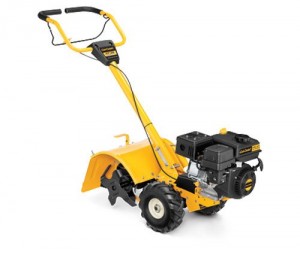 Today’s tillers are both exceedingly powerful and surprisingly efficient, and they’re becoming a more common addition to the stable of home landscaping tools enjoyed in residential environments. Those new to tillers, however, can probably benefit from a few quick tips that will make the whole process a bit easier, safer, and faster to complete. Before getting started with a brand new Cub Cadet garden tiller, consider a few tips that will make it easy to manage challenging terrain, compacted soil, and some of the more common frustration points encountered by the average homeowner.
Today’s tillers are both exceedingly powerful and surprisingly efficient, and they’re becoming a more common addition to the stable of home landscaping tools enjoyed in residential environments. Those new to tillers, however, can probably benefit from a few quick tips that will make the whole process a bit easier, safer, and faster to complete. Before getting started with a brand new Cub Cadet garden tiller, consider a few tips that will make it easy to manage challenging terrain, compacted soil, and some of the more common frustration points encountered by the average homeowner.
Start with Safety Before Starting the Tilling Process
Tillers’ ability to dig through the soil and provide a fertile environment for early planting is largely because they have very sharp tines and very powerful engines. To avoid major injuries, always start the tiller outdoors in an open area, away from pets or other bystanders. Adjust the tines only when the equipment has been turned off and the spark plug removed, and always use appropriate gloves and other safety gear to get the job done. When tilling, walk slowly and deliberately to avoid hitting rocks or creating projectiles of lawn debris. To be safe, wear protective goggles that will keep any airborne debris from damaging the eyes.
Getting Started: Key Tips for Better, Easier Tilling Around the Home
With safety precautions taken and the tiller ready to start operation, homeowners should consider a few basic tips to make their job just a touch easier from start to finish. Among the most common ways to improve the tilling experience:
- Don’t Get Overly Ambitious with Tilling Depths
Using a tiller is much like using a snowblower after a particularly severe winter storm: For the rest results, it’s a good idea to start shallow and dig deeper over time. This is especially true if an area has never been tilled or otherwise maintained previously. Till just an inch or two into the soil and then, when that work is finished, adjust the tines and go a bit deeper. This will prevent jammed tines and overheated engines, which could otherwise lead to some serious maintenance headaches.
- Prepare for Tilling By Watering the Area
Moist soil is far easier to till than dry, compacted soil that hasn’t seen a drop of water in days or weeks. To make tilling just a bit easier, prepare by extensively watering the areas a day or so in advance of the work. This will loosen the soil slightly and, when combined with shallower initial tilling depths, will make it easier to get the job done without headaches or equipment damage.
- Go Along for the Ride and Let the Tiller Do the Work
Homeowners who are new to tiller operation have a tendency to “force” the equipment to do things that it wouldn’t ordinarily do. Some homeowners push the equipment forward at a pretty fast clip, when the truth is that most Cub Cadet tillers are self-propelled and will operate at the perfect speed for ground conditions. Let the tiller do the work here and enjoy less fatigue, less wasted fuel, and fewer maintenance concerns.
Another key thing to remember is that the tiller should never be forcibly pushed downward into the soil. The tines are deliberately adjusted to the perfect depth in advance of tilling procedures. They can be readjusted later and the area can be covered a second time, but the tiller should never be forcibly subjected to deeper tilling if it isn’t prepared in advance. Doing so can ruin the tines and cause major problems.
- Use Extreme Caution on Solid Ground
Very solid, compacted, and hard soil can cause major problems for the tiller. The nature of the tines means that tillers in this environment have a tendency to rapidly accelerate and move forward at a high rate of speed. Be vigilant during tilling and, if this behavior occurs, be prepared to stop the equipment and let go of the handlebars. Never attempt to hold the equipment back, since this can damage both the tiller and the operator.
- Don’t Let Interactions with Debris Go Unanswered
Most homeowners will occasionally run into a rock or other debris as they’re tilling the land around the home. That’s perfectly normal, and tillers are generally designed to withstand the occasional interaction with lawn debris. It’s important, however, to make sure that no damage has been done. Before continuing with scheduled tilling, stop the equipment and give it a thorough inspection to make sure that no permanent damage has been done to the shields, tines, and other key parts of the machine.
For Tillers, Parts, and Safety Gear, Check Out CubParts.com
Safe and enjoyable use of tilling equipment from Cub Cadet often means using the company’s OEM replacement parts during maintenance and its safety gear during operation. CubParts.com makes it easy to find everything homeowners need, with an intuitive online parts lookup tool that can suggest the proper replacement items by using the tiller’s engine manufacturer, model number, or the exact part number required. It’s a great way to stay safe and effective all season long.
